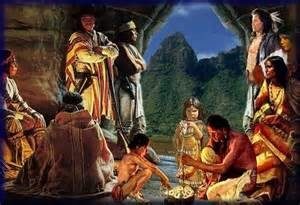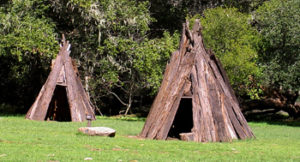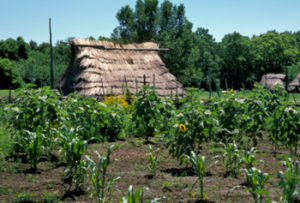
Members of any Shawnee Indian tribe were very hard working. Both genders shared responsibilities equally.
Photo from smore.com
The earliest known occupants of Hunt County were followers of Chief Black Cat who settled in a thicket about nine miles northeast of Greenville. The Indians were identified as Shawnees, although they were more likely what historian Carl Anderson dubbed as “immigrant tribes.”
With the arrival in North America of Eurocentric explorers, European diseases to which the aboriginals had no natural defenses soon decimated Native American populations. Small pox, measles, and similar illnesses reduced the size of tribes to a larger extent than any rifle or sword. As the size of each group diminished, they joined similar linguistic groups and pressed westward in search of a place to call home.
Hunt County was prize land for the immigrant tribes with its fertile soil, available water from clear streams and springs, and adequate timber for fuel. No one knows when these tribes arrived but Black Cat attended a council of tribal leaders and whites at Fort Bird in Tarrant County in 1843. The meeting called by President Sam Houston met beside the Trinity River and produced a treaty ratified by the Republic of Texas Senate. The following year another council treaty signed by twelve tribes, including representatives from Southern Comanche and Lipan Apache took place at Torrey Brothers Trading Post at the Falls of the Brazos. On both occasions Black Cat was the sole Shawnee to attach his mark to the treaties. Along the way Black Cat and Sam Houston developed a strong friendship based on respect.
Black Cat spoke of peace with whites at the first council. “The red man cannot whip the white; we tried it when our race was large, and could not do it. We had better live in peace. We are too small, my red brothers; and it is for that, and the love I bear for your women and children I advise you to make peace. The whites are a great people, covering the earth I know not how far: therefore again I tell you to make peace. The white path now is everywhere.”

Shawnee tribesmen made homes from materials available near the villages.
Photo by Stepheng3 (Public domain), via Wikimedia Commons
Black Cat returned to Hunt County where his people farmed, hunted on the tall grass prairies full of wild game, and even traded with other Native Americans and whites. However, not long after statehood in 1846, Black Cat took his people to Indian Territory for peace and protection.
The tribe was never larger than 150 families. They could not gain clear titles to the land. They were not involved in the Cherokee War led by Chief Bowls. A thicket that early settlers named in honor of the chief surrounded their village. After the tribe moved to the Territory, Black Cat Thicket became a hideout for outlaws. During the Civil War deserters from both sides hid out to avoid conscription. Later such Reconstruction outlaws as Bob Lee, Ben Bickerstaff, Lige Guest and others used it to evade Union occupiers.
After Reconstruction, farmers cleared the brush from all the thickets. From the late 1870s until World War II bountiful cotton crops grew in that area. Drive Highway 34 from Wolfe City to Greenville today and see how the land became a thicket once more. With no farming or grazing the land is returning to its early stages. Even the land doesn’t remain the same.


My grandfather grew up in Black Cat Thicket. His parents moved from Alabama to Texas. On his farm, which has a thicket on it, is a piece of land we own today.
I found out that my great great uncle live there an place called salt lick, the chief used to have a race track there. His name was Tom Malone.
That is correct. Tom lived just a few hundred yards from the salt lick area. I own the land just across the fence from Tom
The Malones are still in the area. They had a property a stone’s through from the Vititoe gin when the 2014 tornado hit. Gary, Billy & Cindy Malone moved out of the thicket after that.
Interesting. My great grandmother was born in Black Cat Thicket in 1842. (My mother’s grand mother…they lived in Aberfoyle from about 1875?—-)
My family lived there too. From Natchez MS. MARICAL was there name.
My great grandfather, Joshua David. Coffee, was in the 14th Brigade, Orangeville Independent Home Guard, Texas State Troops at the outbreak of the War Between the States. During that period, the State Troops pursued deserters, draft dodgers and thieves into Black Cat Thicket. The State Troops were disbanded in 1864 and the men were transferred to regular Confederate army units and they saw action in Arkansas and Indian Territory. My great grandfather enlisted in Lt. Col. Peter C. Hardeman’s 1st Texas Cavalry, Arizona Brigade. He was placed in Capt.John Henry Damron’s Company at Fort Warren, in Fannin County. In October, 1864, Joshua Coffee was detached and assigned to picket duty at Colbert’s Ferry on the Red River until February, 1865. In February, Joshua was reassigned to The Brush Battalion bivouacked on the north end of present day Lake Lavon until the end of the War.
The South Sulfur Cemetery is there and has many old graves of early settlers. My family, Audas, Fulfer and Girdner, settled there and many are buried in that cemetery. I would really enjoy having more information about that area and the early settlers if anyone has any to share.
My parents were born and raised in Black Cat Thicket. It was many years before I asked them how Black Cat Thicket got its name. When they told me, I thought that was so cool! There may be arrowheads and other items on what used to be both sets of grandparents’ land! I’d love to go check it out!